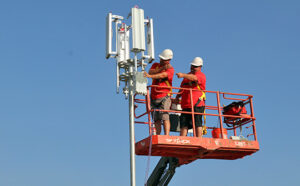 Working from an aerial lift above the roof of TCOE’s Mooney Boulevard office building this week, two technicians installed a four-part antenna to a new mast on the east side of the building. The TCOE antenna is one of four installed in the new Central California Learning Network (CCLN) – a network created to provide high-speed internet access for all Tulare County students at little to no cost. Antennas are being installed at Alta Vista School in Porterville, Strathmore Middle School, and Sequoia Union School in Lemon Cove.
Working from an aerial lift above the roof of TCOE’s Mooney Boulevard office building this week, two technicians installed a four-part antenna to a new mast on the east side of the building. The TCOE antenna is one of four installed in the new Central California Learning Network (CCLN) – a network created to provide high-speed internet access for all Tulare County students at little to no cost. Antennas are being installed at Alta Vista School in Porterville, Strathmore Middle School, and Sequoia Union School in Lemon Cove.
Concrete planning for the CCLN began last year, with support from Kings and Imperial county offices of education and the use of the FCC licenses TCOE has held for over 20 years. The COVID-19 pandemic accelerated the network’s implementation. “The district superintendents and I appreciate the vision of Information Systems department leadership in creating the new network,” said Tim Hire, Tulare County Superintendent of Schools. “The abrupt switch from in-class to distance learning instruction last spring brought to light the difficulties families in rural areas have in providing reliable internet access for their children. District leaders shared countless stories of moms and dads using their phones as hotspots to bring temporary internet service into their homes. Internet access problems in rural areas were compounded for families with multiple school-age children and parents working from home.”
Dr. Wayne Lacy, director of Information Systems, explained that the network is in its pilot phase. “We are beginning to test the infrastructure we are putting in place, gain insight to the network range, and determine the amount of data that can be delivered based on topography and altitude. We are also hoping to combine existing private district networks into a single, cohesive network. The challenges we face are delivering service in the foothills and areas of the county operating on a different frequency – challenges we’ll address with a little creativity.”
Project leaders estimate the network may have an additional four to six antennas by the end of the year.
